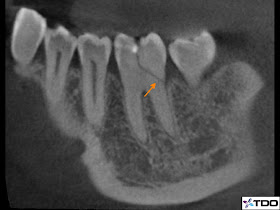http://meadfamilydental.com/2012/05/dont-wait-until-it-breaks/
As a dentist, I see cracks in teeth everyday. After personally experiencing teeth breaking around old fillings, I find myself sharing how painful it was and how it always seemed to happen at inopportune times.
There are two factors that if addressed properly, can pretty much ensure that you can predictably keep your teeth:
The first is health - we emphasize brushing and flossing. Clean teeth do not get cavities and minimizes the chance of gum disease.
The second is function. If you are putting too much force on a tooth - something is going to give once that threshold has been exceeded.
The functional threshold of one of my patient's tooth was exceeded this week. Here is her story -
She presented with EXTREME pain that began suddenly while eating dinner the night before.
I looked at her tooth and saw a fracture on her lower right molar. The fractured part of the tooth was still present and when anything touched it, the segment would move and it sent her into writing agony. The tooth has a well placed conservative filling. I would put this tooth at low risk for a fracture if she presented for a routine exam. The radiograph that we took was inconclusive for a fracture or any other infection.
 |
| Figure 1 -(Tooth #30) fracture noted on left side of tooth extending along the filling through the middle of the lower (lingual) wall. It is slightly brown colored along the filling. |
We attempted to get her numb but was unsuccessful due to the acute problem. Sometimes a tooth is so "hot" (or inflamed) anesthetic doesn't work. When this happens, I get more confident that root canal therapy is indicated.
We referred her over to Dr. Rahim Karmali, a root canal specialist here in Denver, who then did an evaluation that included a three dimensional - CT scan of the tooth.
 |
| Figure 2: CT scan clearly illustrating the extent of the fracture. |
 |
| Figure 3 - Sagital view - fracture down to the boney crest |
 |
| Figure 4 - Shows the fracture extending on the root surface |
The technology that is available to us allows us to better predict the restorability of teeth.
It was obvious to Dr. Karmali, myself and the patient, that this tooth, unfortunately, was not restorable.
So as I mentioned previously that I see cracks in teeth everyday. I am proactive when I see these fractures and tell and show my patients what I see and give options to fix the situation.
When my patient asks me how long before this tooth needs to be fixed. I will reply with the words of my good friend Dr. Mead,
"I recommend that you fix it the day before it breaks!"
I also share this unfortunate experience and hope that it doesn't happen to your tooth...

